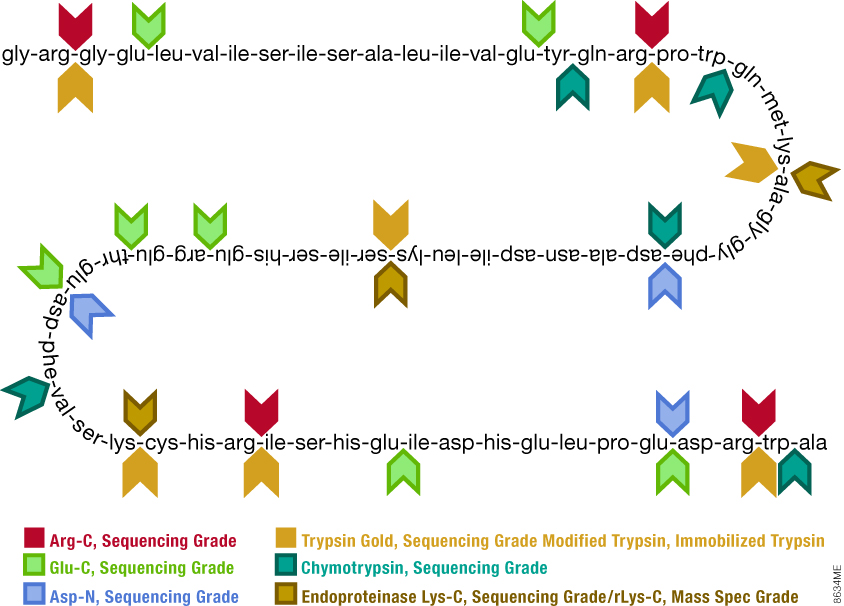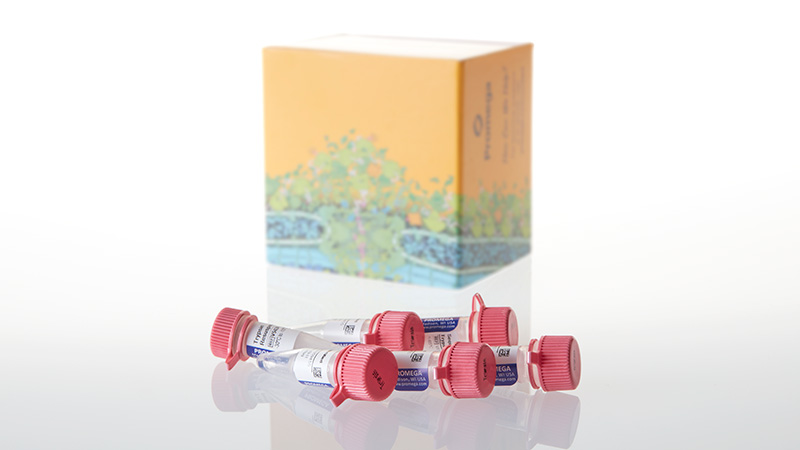Sequencing Grade Modified Trypsin
Trypsin Manufactured for Maximum Specificity and Stability
- Lysine residues modified by reductive methylation, yielding a highly active and stable trypsin
- Available lyophilized or frozen
- Referenced in thousands of papers
Catalog Number:
Choose a Format
Size
$ 106.00
Catalog Number: V5111
$ 94.00
Catalog Number: V5117
$ 50.00
Catalog Number: V5113
Log In to see your price
Trypsin is a serine protease that specifically cleaves at the carboxylic side of lysine and arginine residues. The stringent specificity of trypsin is essential for protein identification. Native trypsin is subject to autolysis, generating pseudotrypsin, which exhibits a broadened specificity including a chymotrypsin-like activity. Such autolysis products, present in a trypsin preparation, would result in additional peptide fragments that could interfere with database analysis of the mass of fragments detected by mass spectrometry. Sequencing Grade Trypsin has been manufactured to provide maximum specificity. Lysine residues in the porcine trypsin have been modified by reductive methylation, yielding a highly active and stable molecule that is extremely resistant to autolytic digestion.
The specificity of the purified trypsin is further improved by TPCK treatment, which inactivates chymotrypsin. The treated trypsin is then purified by affinity chromatography and lyophilized. It is resistant to mild denaturing conditions such as 0.1% SDS, 1M urea or 10% acetonitrile and retains 50% of its activity in 2M guanidine HCl. The activity of trypsin is decreased when acidic residues are present on either side of a susceptible bond. If proline is at the carboxylic side of lysine or arginine, the bond is almost completely resistant to cleavage.
Choose Your Configuration: Learn more about our custom options for this product at: www.promega.com/custom/
Recommended Reaction Buffer: 50mM NH4HCO3 (pH 7.8).
References- Keil-Dlouha, V.V. et al. (1971) FEBS Letters 16, 291–5.
- Rice, R.H. et al. (1977) Biochem. Biophys. Acta 492, 316–21.

Digest sites for a variety of trypsins and proteases.
Specifications
Catalog Number:
What's in the box?
| Item | Part # | Size |
|---|---|---|
|
Sequencing Grade Modified Trypsin, Porcine (lyophilized) |
V511A | 5 × 20μg |
|
Trypsin Resuspension Dilution Buffer |
V542A | 1 × 1ml |
SDS
Search for SDSCertificate of Analysis
Use Restrictions
For Research Use Only. Not for Use in Diagnostic Procedures.Storage Conditions
What's in the box?
| Item | Part # | Size |
|---|---|---|
Sequencing Grade Modified Trypsin |
V511B | 1 × 100μg |
|
Trypsin Resuspension Dilution Buffer |
V542A | 1 × 1ml |
SDS
Search for SDSCertificate of Analysis
Use Restrictions
For Research Use Only. Not for Use in Diagnostic Procedures.Storage Conditions
What's in the box?
| Item | Part # | Size |
|---|---|---|
|
Sequencing Grade Modified Trypsin, Porcine, Frozen (liquid 0.5mg/ml) |
V511C | 5 × 20μg |
|
Trypsin Resuspension Dilution Buffer |
V542A | 1 × 1ml |
SDS
Search for SDSCertificate of Analysis
Use Restrictions
For Research Use Only. Not for Use in Diagnostic Procedures.Storage Conditions
Related Products
Similar Products
Trypsin Platinum, Mass Spectrometry Grade
Maximum digest specificity. Maximum resistance to autoproteolysis.
VA9000
Endoglycosidase H
Characterize protein glycosylation in applications such as monitoring protein trafficking and determining glycan location and structure by mass spectrometry.
V4871, V4875
PNGase F
Catalyzes cleavage of N-linked oligosaccharides between the innermost GlcNAc and asparagine residues.
V4831
Trypsin/Lys-C Mix, Mass Spec Grade
Increased peptide recovery, enhanced protein quantitation, improved reproducibility.
V5071, V5072, V5073
Frequently Used With
Magnetic Proteomics Sample Prep (MPSP) Kit
MPSP magnetic beads for streamlined sample preparation for bottom-up proteomics.
CS3325A04
Arg-C Ultra, Mass Spec Grade
Endopeptidase that cleaves at the C-terminus of arginine residues, including Arg-Pro.
VA1831, VA1832
Lys-C, Mass Spec Grade
Cleavage site: C-terminal of Lys. Optimal pH: 7–9.
VA1170
Chymotrypsin, Sequencing Grade
Cleavage sites: C-terminal of Tyr, Phe, Trp. Optimal pH: 7–9.
V1061, V1062





